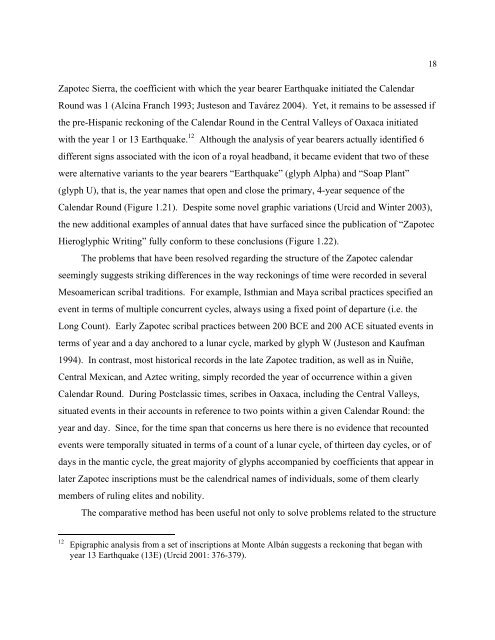Create successful ePaper yourself
Turn your PDF publications into a flip-book with our unique Google optimized e-Paper software.
<strong>Zapotec</strong> Sierra, the coefficient with which the year bearer Earthquake initiated the Calendar<br />
Round was 1 (Alcina Franch 1993; Justeson and Tavárez 2004). Yet, it remains to be assessed if<br />
the pre-Hispanic reckoning of the Calendar Round in the Central Valleys of Oaxaca initiated<br />
with the year 1 or 13 Earthquake. 12 Although the analysis of year bearers actually identified 6<br />
different signs associated with the icon of a royal headband, it became evident that two of these<br />
were alternative variants to the year bearers “Earthquake” (glyph Alpha) and “Soap Plant”<br />
(glyph U), that is, the year names that open and close the primary, 4-year sequence of the<br />
Calendar Round (Figure 1.21). Despite some novel graphic variations (Urcid and Winter 2003),<br />
the new additional examples of annual dates that have surfaced since the publication of “<strong>Zapotec</strong><br />
Hieroglyphic <strong>Writing</strong>” fully conform to these conclusions (Figure 1.22).<br />
The problems that have been resolved regarding the structure of the <strong>Zapotec</strong> calendar<br />
seemingly suggests striking differences in the way reckonings of time were recorded in several<br />
Mesoamerican scribal traditions. For example, Isthmian and Maya scribal practices specified an<br />
event in terms of multiple concurrent cycles, always using a fixed point of departure (i.e. the<br />
Long Count). Early <strong>Zapotec</strong> scribal practices between 200 BCE and 200 ACE situated events in<br />
terms of year and a day anchored to a lunar cycle, marked by glyph W (Justeson and Kaufman<br />
1994). In contrast, most historical records in the late <strong>Zapotec</strong> tradition, as well as in Ñuiñe,<br />
Central Mexican, and Aztec writing, simply recorded the year of occurrence within a given<br />
Calendar Round. During Postclassic times, scribes in Oaxaca, including the Central Valleys,<br />
situated events in their accounts in reference to two points within a given Calendar Round: the<br />
year and day. Since, for the time span that concerns us here there is no evidence that recounted<br />
events were temporally situated in terms of a count of a lunar cycle, of thirteen day cycles, or of<br />
days in the mantic cycle, the great majority of glyphs accompanied by coefficients that appear in<br />
later <strong>Zapotec</strong> inscriptions must be the calendrical names of individuals, some of them clearly<br />
members of ruling elites and nobility.<br />
The comparative method has been useful not only to solve problems related to the structure<br />
12 Epigraphic analysis from a set of inscriptions at Monte Albán suggests a reckoning that began with<br />
year 13 Earthquake (13E) (Urcid 2001: 376-379).<br />
18

















